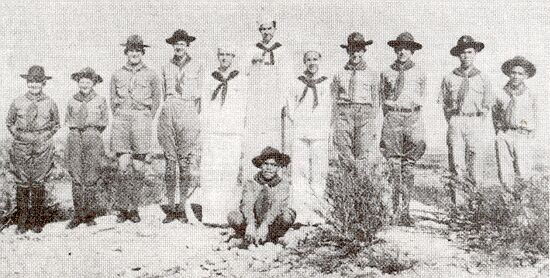 |
|
International FlareBids for PeaceThe flare was international in nature, as Round Mountain that it was built on, enabled one to see the flicker of light of the burning torch both in Mexico and the United States.
The Scouts constructed the pillar themselves, carried the necessary supplies on their backs up the side of the steep hill. It was of interest that two Spanish American troops sponsored by the L.U.L.A.C. Society participated in this gesture for world peace. Each of the five troops and one Sea Scout Ship took turns by months to keep the flare burning all through the year. No one group could claim credit for the peace flare, as it was the outcome of the thoughts and feelings of the various Del Rio Scouts and Scout leaders. The units that helped build
the flare site were:
The pillar was filled with oil and kept burning for one year as a symbol of peace and good will from December 3, 1937 to December 3, 1938. The pillar was dark for fifteen years, until February 8, 1952. That day was selected as the day to kindle the light once again, on the day of the birthday of Scouting in America. Elaborate ceremonies were held for the lighting of the pillar once again. The Scouts met at the Del Rio Chamber of Commerce and marched one mile to the Brown Plaza in San Felipe. There they were met by the San Felipe Latin-American high School band, and then they marched another mile to Round Mountain, led by the band. A ceremony was held at the crest of Round Mountain, where the pillar was located. The fire was relighted by Pilar Garza, Del Rio Scoutmaster, who was the holder of the Silver Beaver and one of the three adults who assisted in erecting of the pillar in 1937. Following the lighting of the pillar, all those present closed the event by repeating the Scout Oath. It only burned for that one night. We know that one of the original builders of the pillar, John H. Walk of Del Rio, was killed in Germany during World War II. As of 1952, two of the three leaders, who helped build the pillar, were still residents of Del Rio and were still active in Scout work. One was Sam H. Walk, father of John, and the other was Pilar Garza, a local grocer. Walk had served as President of the Concho Valley Council from 1947 through 1948 and was a representative to the National Council. Walk was presented the Silver Beaver in 1939. Garza had been a Scoutmaster for 27 years. He was presented the Silver Beaver in 1948. The third leader was Boyd Loveless. later with the West Texas Utilities in Sonora. Here is what was recalled by Sam Walk in 1952 about what had happened to some of the Scouts: Herbert Bradle became a minister.
Material for this story was taken from "Panjandrum A History of Scouting in the Concho Valley Council 1911-1941," by Frank T. Hilton, 1990, and from the Standard-Times, February 6, 1952 Last Updated: February 27, 2004 Return to Home Page |
